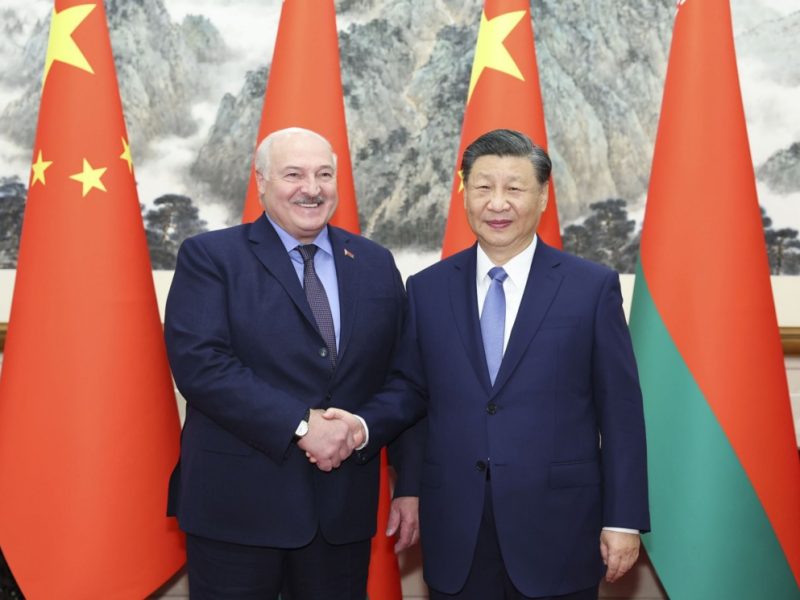As the flames of conflict continue to burn in Ukraine, an alarming alliance is taking shape, one that could upend the balance of power on the global stage.
PRC’s deepening strategic and military partnership with Russia, which intensified following Russia’s offensive against Ukraine in February 2022, is becoming a significant concern for the United States and NATO. In response to this growing partnership, U.S. Secretary of State Antony Blinken has recently emphasized the importance of continuing sanctions on Russia to maintain pressure and curb its aggression. China plays a crucial role in supporting Russia’s defense industrial base.
“Chinese contributions allow Russia to sustain its military efforts. They enabled Russia to keep that defense industrial base going, to keep the war machine going, to keep the war going. So that has to stop.” – Anthony Blinken
Initially, there were doubts about China’s direct support for Russia’s war efforts, particularly regarding the provision of lethal aid. However, recent evidence has unmasked this myth, revealing China’s direct involvement in supplying crucial military components to Russia despite official claims of neutrality. Readers can explore the details and implications of this involvement further in the article. Notably, joint military exercises involving Chinese and Belarusian troops, conducted near the Belarusian city of Brest, just five kilometers from the Polish border, underscore their growing military cooperation. The timing of this drill suggests that the Chinese Communist Party is signaling to the United States its potential willingness to support Russia in a conflict involving NATO and Europe.
Unveiling the Truth: China’s Full-Scale Support for Russia in the Ukraine War
China’s involvement in supporting Russia’s war efforts has been multifaceted despite Beijing’s official neutrality. Recent revelations and documents suggest a more complex reality.
Chinese companies have supplied Russia with essential components to sustain its military operations in Ukraine. For instance, records obtained by BelPol reveal that Shenzhen-based Green Cycle Energy provided Belarusian defense contractor BelOMO Holding with precision parts crucial for laser-guided bombs and missiles. This transaction, which continued even after the U.S. Treasury Department sanctioned BelOMO, indicates that Chinese companies contribute to Russia’s arms supply chain despite international sanctions. In fact, China’s support for Russia’s military extends beyond mere supply chains. Chinese firms have been involved in transactions with Belarusian contractors directly linked to Russia’s military efforts. For example, Morotack (Tianjin) Technology supplied critical components to BelOMO, and St. Petersburg-based Precision Laser Systems exported laser-related parts with Chinese-produced laser diodes to Belarusian contractors. This interconnection underscores the deepening ties between the Chinese and Russian defense sectors.
According to a CNN report following Secretary of State Antony Blinken’s discussions with US allies, “China continues to steer clear of providing Russia with lethal weaponry, which the US has warned against since the beginning of the Ukraine war, but in many cases, the inputs can be just as impactful as lethal weaponry.”
Beyond supplying components, there is growing evidence of tactical collaboration between Chinese and Russian defense industries. Reports suggest that Russia is sharing battlefield intelligence with China, potentially revealing vulnerabilities in Western weapons systems. This exchange of information is a concern for the U.S. and allied forces, as it may undermine the effectiveness of their military technology in future conflicts. The U.S. and European countries increasingly focus on tightening sanctions and monitoring Chinese companies involved in this indirect support.
Joint Military Exercises in Belarus: Why Is This Important?
On July 15, 2024, as China and Russia launched joint military exercises in the South China Sea, NATO leaders adopted a joint declaration labeling China a ‘decisive enabler’ of Russia’s war against Ukraine. This declaration came just as Chinese and Belarusian troops commenced their joint exercises near Brest on July 8, sending a clear message to NATO. The drills included anti-terror training, interpreted as a warning signal rather than just a routine exercise. This and the fact that such missions were rare and notable for their timing made the situation more alarming. It implied that China was prepared to directly support Russia and potentially challenge NATO.
The deputy head of the Belarusian Armed Forces claimed the maneuvers were a response to Western aggressive foreign policy and Ukrainian provocations, further escalating tensions. These coordinated military maneuvers underscore the PRC’s strategic objective to not only support Russia but also to challenge and threaten NATO’s presence and influence on its eastern flank.
As Beijing and Moscow strengthen their ties, the West faces an increasingly complex and dangerous geopolitical landscape where the traditional dominance of the United States and its allies is seriously threatened. NATO Secretary-General Stoltenberg’s recent remarks reflect this heightened urgency, warning that the world has entered a new era of ‘enduring competition with China.’ Stoltenberg emphasized the interconnectedness of European and Asian security, underscoring NATO’s broader strategic focus. The alliance has also highlighted China’s growing role in supporting Russia’s war efforts, signaling a shift in NATO’s strategic posture towards greater vigilance in the Indo-Pacific region. Especially considering the fact that in the last week of July, extensive naval activities have unfolded in the Indo-Pacific, with over 18 Chinese and Russian Navy ships participating in joint exercises and patrols and the Shandong carrier group concluding a 10-day drill east of Taiwan, highlighting China’s increasing military assertiveness in the region. At the recent NATO Summit, leaders reaffirmed their commitment to countering these threats, strengthening cyber defenses, and enhancing collaboration with Indo-Pacific partners to address the challenges posed by China’s global ambitions. Following this summit, a new NATO plan has been revealed, with Germany preparing to mobilize 800,000 troops and massive logistical support through critical infrastructure in the event of a conflict with Russia. Readers can find a more detailed assessment of this plan and its implications further down in this article.
These events have significant implications. As China and Russia strengthen military ties, NATO’s actions—like bolstering its Eastern Flank and forming strategic Asian partnerships—reflect an escalating global power struggle beyond traditional boundaries.
Additionally, another concern is the potential transfer of battlefield innovations and lessons learned from Ukraine to China’s People’s Liberation Army (PLA). U.S. officials worry that the PLA could adopt Russian military tactics and countermeasures, thereby enhancing its capabilities in a potential conflict with the U.S. or its allies in the Indo-Pacific region. This concern is heightened by the PLA’s involvement in joint exercises with Russia and Belarus, notably the Eagle Assault-2024 drill near Brest. Despite its “anti-terrorism label,” the exercise is perceived as a show of military strength and resolve against NATO, with tasks like hostage rescue masking its true purpose of demonstrating Chinese and Russian military capabilities.
Strategic Implications for NATO and the U.S.
The strategic partnership between China and Russia, often described as a “no limits” partnership, presents a multifaceted challenge to NATO and the U.S. The alliance’s growing military cooperation, particularly in the fields of nuclear and conventional forces, signals a concerted effort to undermine Western influence and security. The recent NATO declaration, which labeled China a “decisive enabler” of Russia’s war in Ukraine, reflects the seriousness with which the alliance views this emerging axis of power.
China’s support for Russia is not limited to military cooperation. The economic ties between the two nations have strengthened significantly since the onset of the Russo-Ukraine war, with trade volumes surging despite international sanctions on Russia. China’s provision of satellite imagery, microelectronics, and other dual-use technologies has been crucial in keeping Russia’s military-industrial complex operational, further entrenching the two countries’ interdependence.
Amid these developments, the world is also focused on the significant military maneuvers occurring in Europe. While attention has been paid to the China-Belarus military exercises, NATO’s new plan to deploy up to 800,000 troops and significant military assets has surfaced. This plan, detailed by Der Spiegel, outlines Germany’s strategy to rapidly mobilize many troops and equipment across Europe, focusing on key routes that could be vulnerable to Russian attacks. In light of this development, China’s strategic posture is increasingly precarious. It can also be said that the challenges posed by China’s support for Belarus (which undermines the strength of international sanctions) might have partly been motivated by NATO’s decision to deploy up to 800,000 troops, reflecting a heightened response to the evolving geopolitical threat. Additionally, the scale and immediacy of NATO’s deployment plan heighten the stakes for China, which has been strengthening its military alliance with Russia and participating in joint exercises with Belarus. The timing of NATO’s readiness measures intensifies China’s sense of vulnerability and urgency, reflecting a growing geopolitical tension as Beijing recalibrates its strategy in response to the expanded Western mobilization.
The special irony lies in China urging Ukraine to de-escalate in Kursk while actively deepening its military and economic ties with Russia, facilitating the killing of not only Ukrainians but also Russians in this war.
One must also take into account that Polish President Andrzej Duda’s visit to China and the threat of closing the Polish-Belarusian border pushed Belarus to make significant governmental changes. Lukashenko appointed pro-China officials, like Dmytry Krutoy, to strengthen ties with Beijing and Moscow. Krutoy, tasked with overseeing relations with Russia and China and advising the new Belarusian ambassador to China, is a technocrat favorable to China. This maneuver ensured Belarus remained a key transit route for Chinese trade, reinforcing its strategic partnership with China while maintaining support from Russia.
China’s influence increasingly overshadows Belarus’s sovereignty. The joint military exercises and Belarus’s entry into the China-led Shanghai Cooperation Organization exemplify Beijing’s deepening involvement. China’s strategic engagement with Belarus not only bolsters Russia’s position in the Russo-Ukrainian war but also supports autocratic regimes, complicating efforts for a peaceful resolution in Ukraine.
A Broader Geopolitical Shift
The Sino-Russian partnership is also part of a broader geopolitical realignment that includes other authoritarian regimes, such as Iran, North Korea, and Belarus. This emerging axis is challenging the Western-dominated international order and seeking to carve out a new multipolar world. The Shanghai Cooperation Organization (SCO), which recently admitted Belarus as its 10th member, is one platform where these countries coordinate their efforts to counter Western influence.
For NATO and the U.S., the implications of this strategic realignment are becoming increasingly urgent. Recently, Belarus has been positioning itself for a signficant role within BRICS, anticipating a boost in status from the forthcoming summit in Kazan. This move highlights the growing integration of Belarus into a broader coalition of authoritarian states that includes China, Russia, and Iran. The Shanghai Cooperation Organization (SCO), which Belarus recently joined, and BRICS, where Belarus is seeking membership, both reflect a concerted effort by these nations to challenge the Western-dominated international order.
This evolving axis is not just symbolic; it poses real challenges. The alliance must prepare for potential coordinated actions across various fronts, including joint military operations and economic tactics, which could destabilize Western democracies. The recent discussions in Minsk, attended by representatives from BRICS and other key states, also underscore the seriousness and complexity of this emerging geopolitical landscape.
Author: Mariam Kasradze




